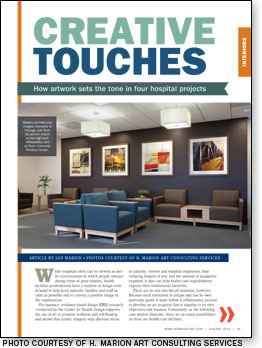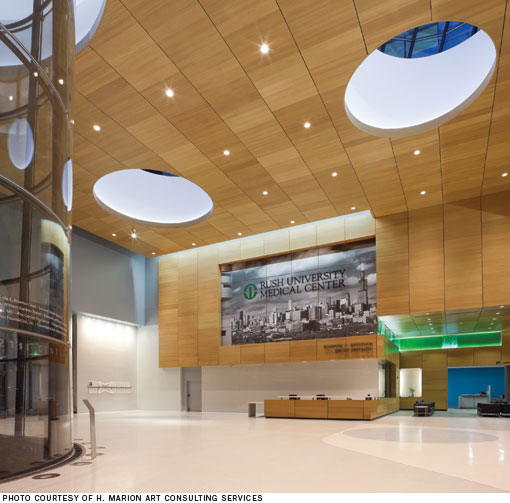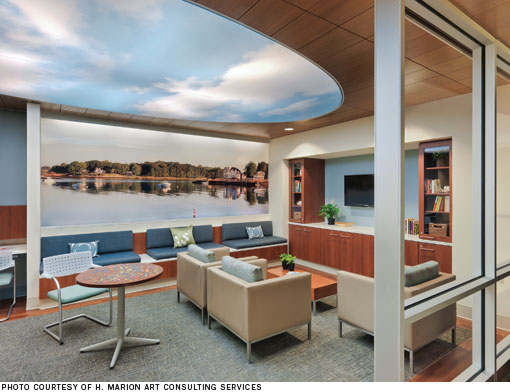 While hospitals often can be viewed as sterile environments in which people interact during times of great tension, health facilities professionals have a number of design tools at hand to help keep patients, families and staff as calm as possible and to convey a positive image of the organization.
While hospitals often can be viewed as sterile environments in which people interact during times of great tension, health facilities professionals have a number of design tools at hand to help keep patients, families and staff as calm as possible and to convey a positive image of the organization.
For instance, evidence-based design (EBD) research conducted by the Center for Health Design supports the use of art to promote wellness and self-healing and shows that artistic imagery may alleviate stress in patients, visitors and hospital employees, thus reducing lengths of stay and the amount of analgesics required. It also can help health care organizations express their institutional identities.
There are no one-size-fits-all solutions, however. Because each institution is unique and has its own particular goals, it must follow a collaborative process to develop an art program that is singular to its own objectives and mission. Fortunately, as the following case studies illustrate, there are as many possibilities as there are health care facilities.
Branding an urban hospital facility
Rush University Medical Center, Chicago
East Patient Tower: Project installed in 2012
304 beds
1 million square feet
1,400 artwork pieces
When those responsible for the ambitious Rush Transformation Project were deciding how to build an outstanding patient and family-centered healing environment, they looked beyond the stunning architecture and furnishings to what's on the walls to help reduce stress and foster a sense of well-being for all who come to the facility.
Rush mandated the art installation team focus on choices of artwork that would:
- Be contemporary, acting as an interior finish and complementing the 14-story, mid-century modern-style building designed by the international architecture firm Perkins+Will.
- Reflect Chicago as a world-class city, showcasing the diverse cultures of the neighborhoods that the hospital serves.
- Include Midwestern natural imagery, providing healing EBD elements.
The curvilinear five-story tower housing the 304 patient rooms sits atop a six-story rectangular base housing the emergency center and a variety of services, operating and treatment rooms. The disparate functional areas, shapes of the corridors with walls of glass, mandatory hospital signage and modernist sensibility of the architecture all created design elements to be considered in choice and placement of the artwork.
Responsiveness to the hospital's objectives is clear upon entering the facility. Walking into the new main entrance of the east tower, the visitor is initially struck by the colossal 30-by-20-foot photographic cityscape of Chicago mounted high on the entry wall of the striking four-story, sun-infused atrium. Comprising 63 digitally combined shots from the vantage point of the hospital, the installation looms over visitors and welcomes them to the complex. It also conveys to visitors that they're entering the city of Chicago's primary hospital.
Complementing and contrasting with this urban image are a series of etched and hand-carved glass
panels depicting prairie grass, edge-lit from below and introducing the Midwestern-inspired organic imagery infusing many of the 1,400 pieces installed throughout the hospital. Many of the works are by local artists from a variety of communities, reflecting familiar scenes and making the venue feel more accessible.

The art installation team also trolled the organization's archives in an effort to pay homage to the hospital's more than 170-year history. From this research, the team created an installation of vintage posters advertising the Woman's Board annual fashion show, from its inception in the 1920s to the present, which the team fittingly hung beside the entrance to the Woman's Board gift shop. It also created a photo series of an ornate Louis Sullivan-era staircase in the neighboring Jones building, which is scheduled to be demolished.
Some other highlights of the project include the following:
- Artwork on the interior walls echoes the hospital's open-air terrarium, with photos, prints and collages of natural imagery including rocks, streams, trees and flora.
- Whimsical childlike art and sculptures of children happily climbing on ropes are showcased in the brightly colored pediatrics family lounge.
- Art in the connector bridge to the employees' cantina pays homage to the many restaurants in the area, including photos of the city's iconic Superdawg drive-in.
The art installation team worked closely with the hospital's executive art committee over 18 months on the project, with options, user-group engagement and sign-off approvals often conducted through an online art review and comment system.
Saluting a unique business legacy
Gottlieb Memorial Hospital, Melrose Park, Ill.
Administrative Offices:
Project installed in 2009
Nine artwork pieces
When Loyola University Health System purchased Gottlieb Memorial Hospital, the administrators wanted to preserve the connection between the hospital and the founding Gottlieb family while renovating the facility to optimize patient care.
An art installation team was called in to consult for the administrative offices, and the ideas started to flow when the team learned that the hospital's founder David Gottlieb had started D. Gottlieb & Co. pinball manufacturers in 1927 — one of the world's leading pinball businesses and inventors of the "flipper."
The team's creative approach to sustaining the legacy of the Gottlieb family took the form of incorporating the decorative back panels found in the old Gottlieb pinball machines into art installations. This preserved not only the family name, but also the little-known connection to the family business.
The art installation team researched and acquired three vintage or reproduced Gottlieb pinball machines at a convention and transformed the back glass of each into framed art, installing them on the walls of the hospital's administrative offices. Interestingly, the team had difficulty finding pinball machines appropriate to use in a Jesuit institution — many of the designs included drinking, smoking and scantily clad women.
The reaction to the unique tribute to the Gottliebs' generosity has been universally enthusiastic. Besides bringing to life the founders' contributions to the hospital, people come from all over to see the unusual vintage art pieces. One of Gottlieb's family members, when visiting the hospital, even cried upon seeing the pinball back glass.
Showing art's therapeutic value
Northwestern Memorial Hospital, Chicago
Galter Pavilion, three floors of renovation: Project installed in 2011
89 beds
116,000 square feet
106 artwork pieces

It is a well-established tenet of EBD that certain colors and images can have a positive effect on a patient's overall well-being and support the healing process. However, can art actually heal?
This is the possibility that an art installation team explored with world-renowned psychiatrist John Csernansky, M.D.; the global architecture firm of HOK; and the staff at Northwestern Memorial Hospital (NMH). As part of the multimillion-dollar renovation of NMH, the locked psychiatric ward in the Galter Pavilion was completely reenvisioned. This unit was one of the three floors of the NMH project for which the art installation team consulted.
Because psychiatric patients are sometimes unaware of time of day or even place, the team's goal was to use artwork to help adjust the circadian rhythms within the patient on the theory that the enhanced sense of time can provide an additional therapeutic layer to the treatment protocol.
Working together, the psychiatric team and the art team came up with an interactive installation that combines landscape imagery with technology and actively employs art as part of the healing process — in this instance, light boxes installed behind the artworks that can be controlled to imitate the light at different times of day.
The art installation team selected photographs of landscapes conducive to being enlarged to huge proportions. These were printed on large-scale polycarbonate panels and then illuminated from behind using dimmable light boxes recessed into the wall so the face of the acrylic panels is flush with the drywall. The panels are 8 feet tall and 20 feet long in the corridors and common rooms, and 4 feet high by 6 feet long in the patient rooms. Staff can readily change the time of day depicted in the image from day to night or any time in between by adjusting the dimmer switch.
Hospital staff carefully vetted suggestions through the online art review and comment system and the criteria for artwork in the psychiatric unit were very restrictive.
For instance, the team eliminated artwork if the colors were too gray or misty, because depressed patients need vibrant colors and warmth. For the same reason, landscapes that are arid or without signs of life were considered too desolate. Manic patients can be hypersexual, so images such as close-ups of flowers were rejected as overly suggestive. Psychotic patients can see images in the most benign piece and can sometimes be hyper-religious, so any image that could feed into a delusion — even strong sunlight streaming through trees — was rejected.
Another challenge was ensuring that the mounting and installation of artwork, as well as the inset acrylic panels, were entirely safe for patients of the locked unit. The art installation team came up with a unique installation protocol that permanently mounted the art to the wall with no gap between the two. This ensured that nothing could be slipped behind the art to pry it off the wall or attached to the frame to cause self-harm.
While the art installation team and the physicians in the unit await the evidential outcome of the pairing of art with technology on circadian rhythms, countless patients already have commented positively on the pictures.
Identifying with local traditions
St. Mary's Hospital, Madison, Wis.
Inpatient expansion:
Project installed in 2007
250,000 square feet
113 artwork pieces
Before an installation team began work on the art program at St. Mary's Hospital in central Wisconsin, it needed to understand the environment familiar to the patients living in the region. This was all part of an effort to give the residents of the 18-county area served by the hospital images with which they could identify, both in terms of nature and the local cultures.
The team's selections focused on evidence of life occurring throughout the year, even in the harshest season. As a result, one encounters organic imagery throughout the building, chosen to represent all four seasons to reflect the cycle of nature that is pronounced and distinctive in this northern climate.
The cornerstone of the installation was a commissioned piece located on a curved feature wall in the cardiac rehabilitation area. The life-sized photographic images of the four seasons are meant to act as a metaphor for the circle of life and the healing process itself. The wall also served as a design template for the original and limited-edition prints specified for the rest of the installation.
Special effort was made to include artwork by local artists to reflect the region's personality because they generally paint what they know. Central Wisconsin has one of the largest Hmong populations in the country, so the art installation team made sure to include a significant representation of works by artists from that mountainous Asian region. Their distinctive textile pieces with an Eastern influence are popular highlights of the installation.
Valuable touchstones
Evidence-based principles serve as valuable touchstones for art installation teams working in health care facilities. The versatility of EBD allows for solutions that are consistently beautiful and therapeutic.
This flexibility is particularly important because there are no cookie-cutter solutions. Each project must be viewed with an entirely fresh eye and the team must use EBD in the most personalized manner possible to achieve each hospital's distinctive goals.
Jan Marion is owner and president of H. Marion Art Consulting Services, Wilmette, Ill. He can be reached at jan@hmarionframing.com.


